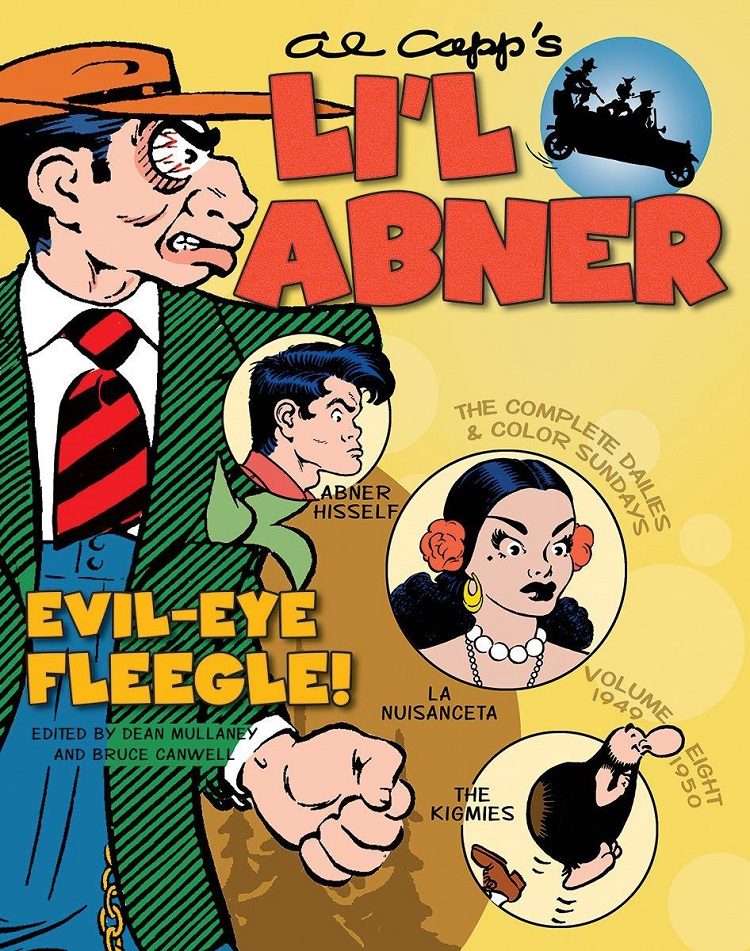
As the Library of American Comics and IDW Publishing continue to collect Li’l Abner: The Complete Dailies and Color Sundays by Al Capp, Volume 8 presents the dailies from December 23, 1948 through to January 11, 1951 and the Sunday strips, which aren’t part of the dailies’ continuity, from December 12, 1948 through to November 12, 1950. The book has an introductory essay, Bruce Canwell’s “Hillbily Heaven” that includes a look at Capp’s feud with former boss Joe Palooka creator Hammond Fisher, which spills into the strip a few times in this book.
Growing up as member of Generation X, reading the Sunday newspaper comics became a weekly ritual. Personally, I stuck to the humor comics over the adventure stories. At the time, I wouldn’t have considered myself a well-rounded connoisseur of the art form nor did I know the word “connoisseur.” Favorites in those early days featured kids that were my age: Peanuts (though I didn’t fully grasp the grown-up anxieties the characters dealt with), Dennis the Menace, and Family Circus, especially the dotted-line comics that mapped out where a character traveled. As I grew into my teens and twenties, I enjoyed popular, more thoughtful strips such as The Far Side, Doonesbury, and Calvin and Hobbes. Yet in all that time, I can’t remember anything being as wildly absurd as Li’l Abner.
Though I was aware of the name, I knew nothing beyond the titular character being some type of farm boy but had no idea he was a dimwitted superman in a Wonderland of his own. This book was my first introduction to the series and I found myself frequently stunned by the imagination of Al Capp, who created a universe that only seems to be governed by whatever ridiculous idea he can think up next.
Yet, I was more aware of the strip than I realized as Sadie Hawkins Day originated in the strip in 1937 and occurs yearly, created by the father of the “homeliest gal in all them hills” so his daughter had a chance at getting married. The annual event sees the bachelors line up and taking off running after a starting gun fires. The women soon follow and “any bachelor whuts caught an’ drug back gotta marry the fair lady whut caught him.” In addition, Skunk Works, the alias for Lockheed Martin’s Advanced Development Programs, took its name from Big Barnsmell’s Skonk Works, where he distill skunk oil.
The book opens with the gorgeous Daisy Mae being kidnapped in order to marry millionaire weirdo Dumpington Van Lump. “Natcherly” (the phonetic language Capp employs for his Dogpatch residents takes a bit to comprehend), Daisy Mae has no interest so Van Lump’s family tries to blackmail her by taking Turnip Termite Exterminator off the market in order to damage the sole industry of her hometown, which will in turn starve the residents. After his Mammy has a specific vision as to her whereabouts, Abner heads off to rescue her.
Capp plays with the perspective while drawing the building, turning it on its side so it runs horizontal in panels. He also plays with point-of-view as a self-aware Abner and Daisy Mae walk by “th’ cause of all [their] troubles,” Capp drawing in his studio. In later strips, the creator announces the date for the return of the popular Schmoos and wishes to rerun a storyline, which he does, from the spring of ’43 about One-Fault Jones because he felt ended it wrong and came up with a better resolution. In the Sunday strips, he announces going on vacation to France and reruns a story while away.
A few of the stories in this book involve Daisy Mae trying to marry Abner, who inexplicably refuses. The first one involves Yokum’s Moon, “which affecks th’ minds o’ all male Yokums – so thet they acks contrariwise.” Daisy Mae hopes this means Abner will propose during this time. There’s a side story about J. Roaringham Fatback, a selfish wealthy jerk (which is how most wealthy people appear in the strip) whose desire for a breakfast comprised of a sun-enriched egg causes him to move the mountain that Dogpatch resides upon rather than move to the other side of his dining table. Abner escapes matrimony with an odd technicality, a common occurrence by Capp in ending storylines.
In the Sunday strips, Abner takes a back seat as there are stories about the Indian Lonesome Polecat wanting to marry Minnie Mustache, who has returned learned from Indian College; a young boy named Washable Jones who encounters the Shmoos and their wicked cousins, the Nogoodniks; and best of all, the Dick Tracy spoof and Abner’s favorite comic strip, Fearless Fosdick, which has a hysterical storyline about Fosdick trying to protect the citizenry from a poisoned can of beans and failing miserably.
The art in the strip is impressive The characters range in appearance from hideous hill folk to some of the most beautiful ladies to ever grace the funny papers. The use of inks to create shadows and details makes the world look believable. While the Sundays are more colorful, I prefer the cleaner look of the black and white dailies.
A very much enjoyed my first encounter with Capp’s Li’l Abner. As silly as they were, the stories were intriguing. My only complaint is the year-long search by Abner to piece together a picture of a woman he was in love with after just seeing her knee, while obviously an excuse to take him to a wide variety of locales and adventures, wore a bit thin. I am looking forward to a return to Dogpatch and recommend a visit to anyone who hasn’t been. Thanks to IDW and The Library of American Comics for making it possible by collecting and releasing the collection.